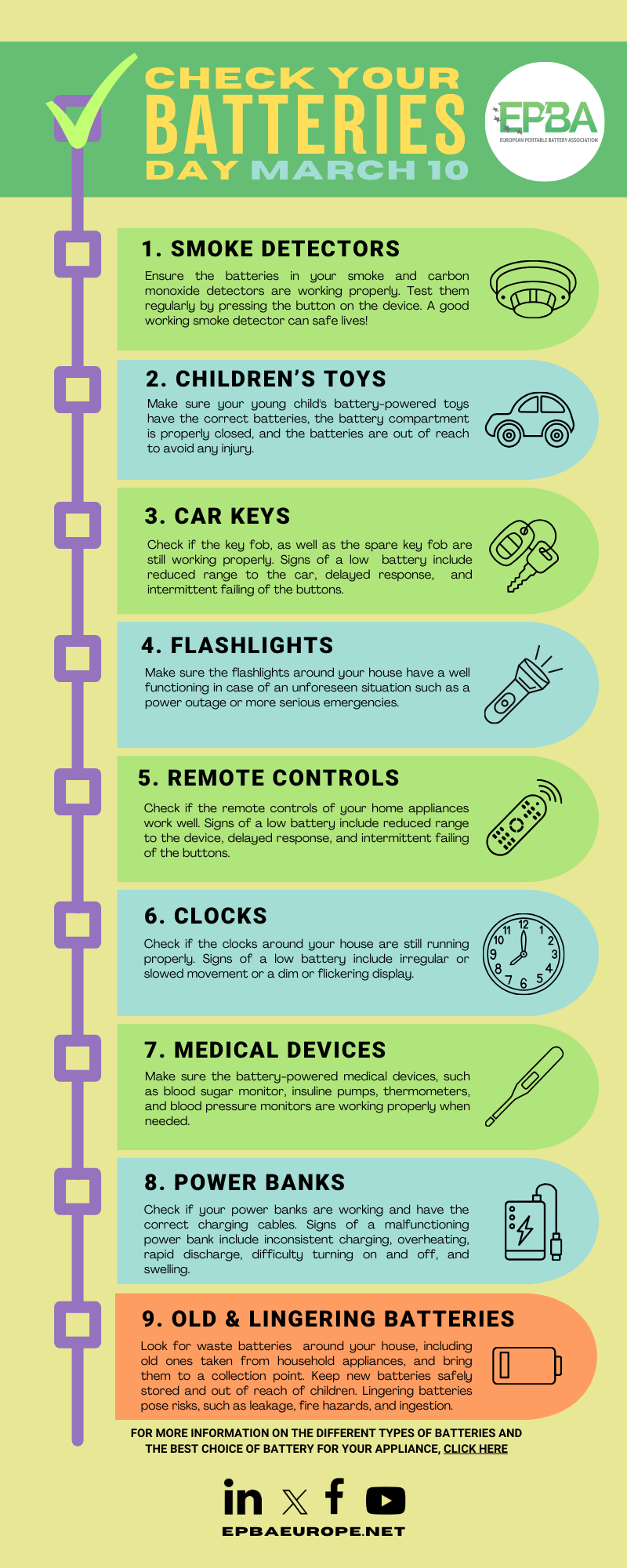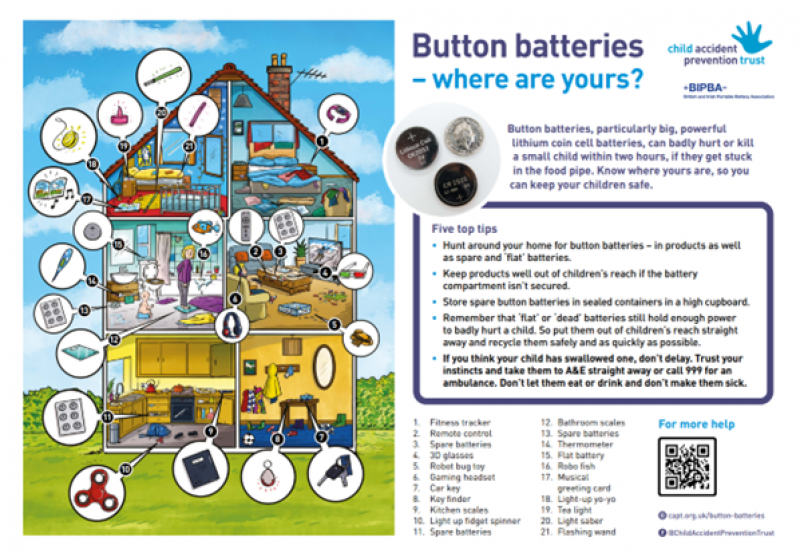News
March 10 is “Check Your Batteries Day”!
Mark your calendars! The second Sunday of March, falling on the 10th this year, is "Check Your Batteries Day"! This day is dedicated to raising awareness about the vital role batteries play in our daily lives.
Our homes are filled with various appliances, many of which rely on batteries. None are more critical than smoke and carbon monoxide detectors. These life-saving devices are our first defense against potentially deadly hazards, providing essential time to evacuate safely during emergencies. However, their effectiveness depends on the batteries powering them, so regular testing and ensuring a working battery is necessary.
This day is more than just about appliances. Consider how many batteries are around your home - old empty batteries and new spare batteries in drawers, as well as old batteries from unused devices - they could be anywhere. This day is the perfect reminder to collect these stray batteries and take them, along with any waste batteries from home appliances, to a designated collection point. Remember to store new batteries safely out of children's reach to prevent accidents.
Let's embrace "Check Your Batteries Day" as our annual reminder to check the functionality of our appliance batteries. We've put together a comprehensive checklist to make this task easier. Download it below and make battery checking a simple step-by-step process for your upcoming Sunday. Your safety may depend on it!

Most importantly, inspect the following appliances for well-functioning and correct batteries:
1. Smoke detectors and carbon monoxide detectors
Ensure that the batteries in your smoke and carbon monoxide detectors are fully charged and working as they should. These devices are your first line of defense against potential disasters, so it is important not to neglect them. Make it a habit to test them regularly to confirm their functionality. You can do this by pressing the button on the device. A smoke detector that is in good working condition can be the difference between life and death, as it can alert you to danger even when you are asleep or in a different part of your home. The same goes for a carbon monoxide detector, which can warn you of this invisible, odorless, deadly gas. Remember, these devices are not just gadgets, but essential tools that can save lives!
2. Children’s Toys
Make sure that your child's battery-powered toys are equipped with the correct type of batteries. This ensures the toys function properly and prevents potential damage or malfunction from using incorrect batteries. Also, ensure the battery compartment is securely closed and locked if possible. Keep spare or used batteries out of children's reach to prevent accidental ingestion or mishandling, which could lead to serious injury, which can be fatal.
3. Car Keys
Check if your car keys, including both the main and spare key fobs, are still working properly. Pay attention to its response time and the distance from which it works. If the range has reduced, or if there's a delay in response time when you press the buttons, it could indicate a low battery. Although most car keys have an integrated analog key for these situations, a depleted battery could still pose significant inconveniences. Therefore, regularly check your car keys and replace the batteries as needed.
4. Flashlights
Ensure that the flashlights in your home are in good working order. They are handy for common situations like camping trips or finding a lost item under the sofa, but also for unexpected circumstances like power outages or more serious emergencies. In such situations, having a reliable light source can make a significant difference. It can help you navigate your home safely, avoid potential hazards, and even signal for help if necessary. Regularly check the condition of your flashlights, replace old batteries, and consider storing the flashlights in key areas around your home (and car).
5. Remote Controls
Ensure that the remote controls for your home appliances are functioning optimally. These devices are critical for operating various appliances, from your television to your air conditioning unit. Conduct a thorough check of each remote control and be aware of signs of a low battery.
There are several telltale signs that a remote control may be running on low battery. One of the more common indications is a reduced range of effectiveness. If you find that you have to move closer to the device than you used to for it to respond to the remote's commands, this could signal a weakening battery. Another sign to be wary of is delayed response. If there's a noticeable lag between pressing a button on the remote and the corresponding action on the device, it might be time to replace the battery. Lastly, intermittent failing of the buttons is another red flag. If you find that certain buttons only work sporadically, or require a harder press to register, it's likely that the battery is running low.
6. Clocks
Take some time to evaluate the functionality of the clocks around your home. Make sure they are all operating as expected. An efficient clock is essential in maintaining accurate time and ensuring your routine isn't disrupted. Signs that may indicate a low battery or a need for replacement include irregular movements of the clock hands, a slower pace than the actual time, or a dim, dull, or flickering display.
7. Medical Devices
Ensure that battery-operated medical devices function as expected at all times. These devices, which are vital for monitoring and maintaining health, include many tools, such as blood sugar monitors that help keep track of glucose levels in the body, and insulin pumps, which are crucial for diabetic patients to regulate their insulin levels. Thermometers, too, are essential for measuring body temperature and detecting fevers, while blood pressure monitors are necessary for people who need to keep an eye on their blood pressure levels regularly. Ensuring these devices are in impeccable working condition when needed can make a significant difference in health management and estimating emergency situations.
8. Power Banks
Ensure that your power banks are working optimally and that you have the correct charging cables compatible with your devices. They are beneficial in circumstances such as power outages, where they can keep your devices powered up. Therefore, ensure that the power banks are in the best possible condition to serve their purpose whenever you need them.
There are several notable signs that you need to look out for to determine if your power bank might be malfunctioning. These include inconsistent charging where the power bank doesn't maintain a steady charge, overheating which can be dangerous, rapid discharge which suggests the battery can't hold its charge for long, difficulty in turning the power bank on and off, and swelling which is a clear indication of a battery issue.
9. Old & Lingering Batteries
Our final, but certainly not least important point, involves identifying and safely disposing old batteries that may be lingering around the house. It may come as a surprise to learn that the average household typically has around 30 waste batteries just lying around unused. It's important to take the time to gather these batteries, which, more often than not, are forgotten once they've outlasted their usefulness.
These discarded batteries, along with the empty batteries taken from home appliances, should be brought to designated collection points for safe disposal. This act of responsible disposal helps declutter your home and contributes to the broader environmental conservation efforts as these batteries can now be recycled. Correct disposal is easy; according to the EU Batteries Regulation, any place that sells batteries is obligated to accept in waste batteries.
Furthermore, it's equally important to ensure that any new stock of batteries you may have are safely stored away in a place that is out of the reach of children. Unattended batteries pose a variety of risks including potential leakage of harmful chemicals, fire hazards due to short-circuits, and other accidents. One commonly overlooked risk is the accidental ingestion of batteries, particularly by young children, which can lead to life-threatening situations. Thus, ensuring the safe storage and disposal of old and lingering batteries is crucial, not just for maintaining order and cleanliness within the home, but more importantly for the safety and wellbeing of your family and the environment at large. For additional guidance on storing batteries in your home safely until you bring them to the collection point, refer to this page by Bebat (Belgium).
Button and coin cells are the most commonly ingested batteries, and they can cause serious harm or even death to small children within as little as two hours. To help you become aware of where these batteries are hiding in your house, check out the infographic below, which was created by the Child Accident Prevention Trust (CAPT) and the British and Irish Portable Battery Association (BIPBA).

Check out our video on how to safely store button and coin cell batteries specifically and what to do in case of ingestion:
